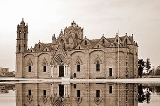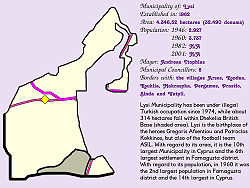
Lysi
Encyclopedia

Mesaoria
The Mesaoria is a broad, sweeping plain which makes up the centre of the island of Cyprus.-Geography:The Mesaoria plain is bounded on the east and west by the Mediterranean Sea, on the south by the Troodos mountains and on the north by the Kyrenia mountains. It has an area of approximately...
plain of the Famagusta
Famagusta
Famagusta is a city on the east coast of Cyprus and is capital of the Famagusta District. It is located east of Nicosia, and possesses the deepest harbour of the island.-Name:...
district of Cyprus, north of the city of Larnaca
Larnaca
Larnaca, is the third largest city on the southern coast of Cyprus after Nicosia and Limassol. It has a population of 72,000 and is the island's second largest commercial port and an important tourist resort...
.
In 1960, there were 3,700 Greek Cypriots living in the village and approximately 6,000 in 1974 when they all fled (August 1974) because of the Turkish invasion and occupation of the north part of Cyprus. Lysi falls within the area of Cyprus which the Turkish army has illegally being occupying until now (2011). Today there are only Turks living in Lysi who occupied the houses of the Greek Cypriots who fled during the invasion. Some of Turks living in Lysi today are settlers from mainland Turkey brought by the illegal Turkish Cypriot authority established after the occupation in order to change the demography of the island, while others are Turkish Cypriots from other villages in Cyprus who moved to Lysi and occupied better and bigger houses that the Greek Cypriots left behind. The town today functions as a Turkish garrison town.
In the centre of the village there is a late 19th century Orthodox church, covered in a thick layer of Gothic decoration copied from the great medieval cathedrals of Famagusta and Nicosia
Nicosia
Nicosia from , known locally as Lefkosia , is the capital and largest city in Cyprus, as well as its main business center. Nicosia is the only divided capital in the world, with the southern and the northern portions divided by a Green Line...
. The church was build by the inhabitants of Lysi who volunteered their work over several years. After the Turkish occupation of Lysi the church was looted, all its Christian icons and other Christian interior decorations were removed and was turned into a moque. Today it functions as a mosque.
The diminutive 14th century church of St. Evphemianos, 2 km southwest of the village, enjoys a lonely position, shaded by a clump of eucalyptus just above a water course. This small church depicted some of the most beutiful and well preserved Byzantine mosaics found on the island of Cyprus. The walls and dome of the church were illegally removed by the Turksih occupiers of Lysi who sold them on the black market. The mosaics were purchased by the Menil Foundation in Texas, USA on behalf of the Greek Orthodox Church of Cyprus and have been on long-term loan to the Menil ever since. The loan agreement comes to an end in February 2012, after which time the works will be returned to Cyprus. West of the village, 2 km along the tarmac road to Arsos village, there is a distinctive hillock capped with rounded boulders. Halfway down its southern face is an Archaic nympheum, a small natural cave that archaeologists found filled with votive statuettes. It has been romantically identified as the grotto of the Cypriot sibyl, whose holiness is immeasurably increased by approaching it along the lay line taken from the near sacred site of Ayios Ephinanios. From this approach, the silhouette of the sibyl's hill hovers as a visual echo of the Pentadaktylos mountains on the northern horizon.
About 4 km further west along this road, the other side of Arsos, is the hamlet of Tremetousia
Tremetousia
Tremetousia is a village in the Larnaca District of Cyprus, located 7 km east of Athienou. The town is one of only four villages in the Larnaca District under the control of the occupying Turkish forces, the other three being Arsos, Melouseia and Pergamos....
, the site of Richard the Lion Heart’s victory over Isaac Comnenus
Isaac Komnenos of Cyprus
Isaac Komnenos or Comnenus , was the ruler of Cyprus from 1184 to 1191, before Richard I's conquest during the Third Crusade.-Family:He was a minor member of the Komnenos family. He was son of an unnamed Doukas Kamateros and Irene Komnene...
. The ruinous church and the buildings on the northern edge are the remains of an 18th century rebuilding of the ancient monastery of St Spyridon
Saint Spyridon
Saint Spyridon, Bishop of Trimythous also sometimes written Saint Spiridon is a saint honoured in both the Eastern and Western Christian traditions.-Life:...
. This very Cypriot
Cyprus
Cyprus , officially the Republic of Cyprus , is a Eurasian island country, member of the European Union, in the Eastern Mediterranean, east of Greece, south of Turkey, west of Syria and north of Egypt. It is the third largest island in the Mediterranean Sea.The earliest known human activity on the...
saint, a shepherd turned local bishop and bulwark of Orthodoxy in the 4th century, lay buried here for a few centuries before being removed to Constantinople
Constantinople
Constantinople was the capital of the Roman, Eastern Roman, Byzantine, Latin, and Ottoman Empires. Throughout most of the Middle Ages, Constantinople was Europe's largest and wealthiest city.-Names:...
. Since the 15th century he has rested on the island of Corfu
Corfu
Corfu is a Greek island in the Ionian Sea. It is the second largest of the Ionian Islands, and, including its small satellite islands, forms the edge of the northwestern frontier of Greece. The island is part of the Corfu regional unit, and is administered as a single municipality. The...
, of which he is the patron saint.

